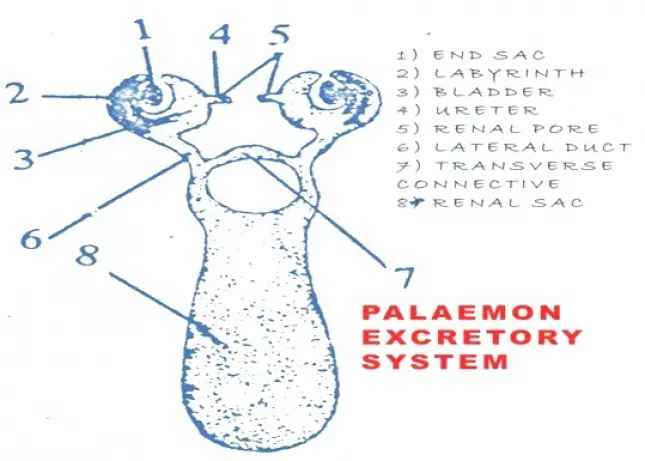Medically reviewed and approved by a board-certified member
Zoology
PALAEMON (PRAWN) EXCRETORY SYSTEM
By BS MediaTwitter Profile | Published: Tuesday, 16 May 2017

Palaemon excretory system contains a pair of kidneys called the antennary or green glands and a median sac called renal sac.
I. Antennary glands: The antennary glands are present in the coxae of the antennae. Each gland is small, and white in color. Each gland shows three parts.
1. End - sac.
2. Labyrinth, and
3. Bladder.
1) End - sac: It is small. It is the central part of the antennary gland. Its wall is folded inside. It has ephithelium and outer connective tissue. The cavity of the end-sac contains a large lacuna. It opens into the labyrinth by a pore.
2) Labyrinth: It is larger than the end sac. It is a mass of branched excretory tubules. They are held together by connective tissue. The labyrinth opens into bladder by several openings. The wall of each excretory tubule is formed by exeretory epithelium.
3) Bladder: Bladder is placed inner side of the end-sac. It opens into renal sac by the lateral duct. It gives excretory duct or ureter, from its inner side. It opens out by the excretory or renal apenure on the inner side pf the coxa of the respective antenna.
II. Renal Sac: It is a large median sac present beneath the dorsal shield. It covers the entire cardiac stomach. Anteriorly it is connected with the bladder of each antennary gland by a lateral duct.
Working: The green glands perform excretion and osmoregulation.
i) Excretion: The green glands are supplied with blood by the antennary arteries. By ultrafiltration water and dissolved substances pass into the end-sacs. The filtrate passes into the labyrinth. By selective reabsorption the useful products are returned to blood in labyrinth. The urine is collected and it flows into the bladders. The excretory fluid also comes here from the renal sac. The urine is passed out through the ureters and renal apertures.
ii) Osmoregulation: Water enters into the body regularly by osmosis. It is collected and sent out by green glands. Prawn passes out huge quantity of water with urine to maintain osmoregulation.
End of the article